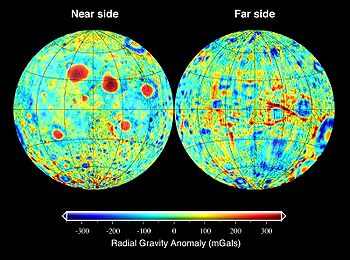Mare Orientale
| Mare Orientale | ||
|---|---|---|

|
||
| Mare Orientale and Rook mountain ring. Right the Lacus Veris | ||
|
|
||
| position | 19.87 ° S , 94.67 ° W | |
| diameter | 294 km | |
| See also Gazetteer of Planetary Nomenclature | ||
The Mare Orientale (German: Eastern Sea ) is a mare of the earth's moon . It is the lava-filled central area of a circular plain. Contrary to its name, the Mare is located in the far west, on the back of the moon , on the border to the front. Hence it can only be seen from Earth when the libration is extreme . Photos of lunar orbiters show a huge, quadruple ring structure of 300 to 1000 km in diameter, the middle rings of which are formed by two circular mountain chains up to 5 km high. The large basin with the lava-flooded central part is the third largest impact basin on the moon after the South Pole Aitken Basin and the Mare Imbrium .
The center of the Mare Orientale has the selenographic coordinates 19.4 ° south and 92.8 ° west. Its name comes from the time before space travel, when the east and west directions were transferred from the earth to the surface of the moon in an astronomical view.
Completion of the "Great Bombardment"

The East Sea is selenologically the youngest mare on the moon and formed 3.85 billion years ago at the end of the great bombardment . In contrast to other Maria, it was only partially flooded with basalts after the impact of the asteroid , because the lunar crust is thicker there. Therefore, many of the original impact structures can still be seen. The dark, smooth Mare Plain in the central part measures around 300 km in diameter and is surrounded by three concentric ring structures that are similar to those when you throw a stone into the water. The diameter of the outer ring wall is about 950 km. Its eastern part is formed by the Montes Cordillera and is still visible at the edge of the moon, sometimes also the next inner ring mountain of the Montes Rook .
The well-preserved ring structure is broken only by a strikingly few younger craters, of which the three largest - Lovell , Maunder and Shaler - measure 120 to 140 km. The 180 km large Schlüter crater is directly connected to the outer northeast edge . Two narrow lava "lakes" have formed between the Cordillera and Rook mountain rings, which have been given the names Lacus Veris and Lacus Autumni .
Mascon and gravity field

Under the Mare Orientale, the first lunar orbits could already detect severe orbital disruptions caused by a large mascon under the lava cover. After the big impact, the lunar crust formed a new equilibrium, but later - after solidification - heavier magma rose into it. In contrast, the concentric ring mountains created by shock waves (blue ring on the right edge of the picture) have strongly negative gravity anomalies because they apparently protrude deeper into the moon's mantle ( isostasis ).
literature
- Patrick Moore et al .: Atlas of the Solar System (especially the back of the moon, western region). 465 p., Herder-Verlag Freiburg-Basel-Vienna, approx. 1990
- J. Oberst et al .: From the Apollo landings until today (history of the surface, mare, elevation models). Stars and Space 8/1999, s. a. PDF
Web links
- Lunar.arc.nasa.gov: Mare Orientale (English)
- The-moon.wikispaces.com: Mare Orientale (English)
- Mare Orientale - Astronomy Picture of the Day from March 12, 2011. (With high-resolution LRO mosaic)
- Spektrum.de : Amateur recordings Mare Orientale 1 , 2 , 3

